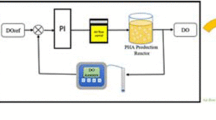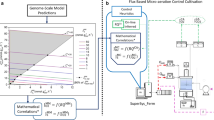Abstract
A cost-minimizing mathematical model for on-line control of dissolved oxygen using agitation speed and aeration rate was developed. In pilot scale monensin fermentation using Streptomyces cinnamonensis, this algortihm provided stable control of dissolved oxygen at 40%, reducing energy usage 27.8%. The agitation and aeration profiles provided by the algorithm respresent the pathway of least energy cost for control at the desired dissolved oxygen level. Other observed advantages of bivariable control were reduction of foaming, evaporation, and gas holdup. Reduced maintenance of compressors and agitator motors could also be expected due to decreased load. Monensin productivity equivalent to fermentation with constant agitation and aeration was not obtained, however, with potency reduced 14.8% with the dissolved oxygen control strategy.
Similar content being viewed by others
Abbreviations
- A m2 :
-
cross sectional area of fermentor
- A 1, A 2, A 3, A 4 :
-
constants of polynomial fit to Calderbank's equations
- BP N/m2 :
-
gauge back pressure
- C ag $/W/s:
-
cost of electrical power
- C Q $/m3 :
-
cost of compressed air
- CE mol/m3/s:
-
carbon dioxide evolution rate
- D m:
-
impeller diameter
- DO, DO meas, DO sp %:
-
dissolved oxyen saturation at any time, measured, and setpoint respectively
- h m:
-
height of liquid in fermentor
- H N/m2/mmol:
-
Henry's constant for oxygen in water
- H av :
-
average gas holdup in fermentor
- k L a, k L a meas, k L k sp s−1 :
-
oxygen mass transfer coefficient at any time, measured, and setpoint respectively
- N, N sp s−1 :
-
agitation speed at any time and setpoint respectively
- N a, N a, sp :
-
aeration number at any time and setpoint respectively
- N i :
-
total number of impellers
- N p :
-
impeller power number
- N s :
-
number of impellers into which air is directly sparged
- OU, OU meas mol/m3/s:
-
Oxygen uptake rate at any time and measured respectively
- P W:
-
ungassed agitation power
- P g, P g,meas, P g,sp W:
-
gassed agitation power at any time, measured, and set point respectively
- Q, Q meas, Q sp m3/s:
-
aeration rate at any time, measured, and setpoint respectively
- T K:
-
fermentation temperature
- u g m/s:
-
linear gas velocity
- V m3 :
-
fermentation liquid volume
- \(y_{{\text{O}}_{{\text{2,}}} out} \) :
-
mole fraction of oxygen in fermentation off-gas
- α :
-
calculation constant
- ɛ :
-
motor efficiency
- φ $/s:
-
sum of agitation and aeration costs
- ρ kg/m3 :
-
liquid density
References
Steel, M. R., Maxon, W. D.: Dissolved oxygen measurements in pilot- and production-scale novobiocin fermentations. Biotechnol. Bioeng. 8 (1966) 97–108
Hersbach, G. J. M.; van der Beek, C. P.; van Dijck, P. W. M.: The penicillins: Properties, biosynthesis and fermentation. In: Vandamme, E. J. (Ed.): Biotechnology of Industrial Antibiotics, Drugs and Pharmaceutical Sciences, vol. 22, pp. 45–140. New York: Dekker 1984
Hilgendorf, P.; Heiser, V.; Diekmann, H.; Thoma, M.: Constant dissolved oxygen concentrations in cephalosporin C fermentation: Applicability of different controllers and effect on fermentation parameters. Appl. Microbiol. Biotechnol. 27 (1987) 247–251
Flickinger, M. C.; Perlman, D.: The effect of oxygen-enriched aeration on neomycin production by Streptomyces fridiae. J. Appl. Biochem. 2 (1980) 280–291
Yegneswaran, P. K.; Gray, M. R.; Thompson, B. G.: Effect of dissolved oxygen control on growth and antibiotic production in Streptomyces clavuligerus fermentations. Biotechnol. Prog. 7 (1991) 246–250
Clark, T. A.; Hesketh, T.; Seddon, T.: Automatic control of dissolved oxygen tension via fermenter agitation speed. Biotechnol. Bioeng. 27 (1985) 1507–1511
Williams, D.; Yousefpour, P.; Weelington, E. M. H.: On-line adaptive control of a fed-batch fermentation of Saccharomyces cerevisiae. Biotechnol. Bioeng. 28 (1986) 631–645
Chen, J.; Tannahill, A. L.; Shuler, M. L.: Design of a system for control of low dissolved oxygen concentrations: Critical oxygen concentration for Azotobacter vinelandii and Escherichia coli. Biotechnol. Bioeng. 27 (1985) 151–155
Cardello, R. J.; San, K. Y.: The design of controllers for batch bioreactors. Biotechnol. Bioeng. 32 (1988) 519–526
Astrom, K. J.; Wittenmark, B.: On self tuning regulators. Automatica 9 (1973) 185–199
Hwang, Y. B.; Seung, C. L.; Chang, H. N.; Chang, Y. K.: Dissolved oxyen concentration regulation using auto-tuning proportional-integral-derivative controller in fermentation process. Biotechnol. Techniques 5 (1991) 85–90
Ko, K. Y..; McInnis, B.; Goodwin, G. C.: Adaptive control and identification of the dissolved oxygen process. Automatica 18 (1982) 727–730
Lee, S. C.; Hwang, Y. B.; Chang, H. N.; Chang, Y. K.: Adaptive control of dissolved oxygen in a bioreactor. Biotechnol. Bioeng. 37 (1991) 597–607
Van't Riet, K.: Review of measuring methods and results in nonviscous gas-liquid mass transfer in stirred vessels. Ind. Eng. Chem. Proc. Des. Dev. 18 (1979) 891–899
Rushton, J. H.; Costich, E. W.; Everett, H. J.: Power characteristics of mixing impellers. Chem. Eng. Prog. 46 (1950) 395–404 and 467–476
Calderbank, P. H.: Physical rate processes in industrial fermentation. Part I: The interfacial area in gas-liquid contacting with mechanical agitation. Trans. Inst. Chem. Eng. 36 (1958) 443–463
Nienow, A.; Machon, V.: Effect of formaldehyde on hold-up in aerated stirred tanks. Biotechnol. Bioeng. 21 (1979) 1483–1486
Peters, M. S.; Timmerhaus, K. D.; Plant design and economics for chemical engineers. 3rd Edn., p. 881. New York: McGraw-Hill 1990
Zanetti, R. (Ed.): Cost Indexes. Chemical Engineering 98 (1991) 204
Cheney, W.; Kincaid, D.: Numerical mathematics and computing, 2nd Ed., pp. 459–462. Monterey: Brooks/Cole 1985
Smith, J. J.; Lilly, M. D.; Fox, R. I.: The effect of agitation on the morphology and penicillin production of Penicillium chrysogenum. Biotechnol. Bioeng. 35 (1990) 1011–1023
Toma, M. K.; Ruklisha, M. P.; Vanags, J. J.; Zeltina, M. O.; Leite, M. P.; Galinina, N. L.; Viesturs, U. E.; Tengerdy, R. P.: Inhibition of microbial growth and metabolism by excess turbulence. Biotechnol. Bioeng. 38 (1991) 552–556
Dunlop, E. H.; Ye, S. J.: Micromixing in fermentors: Metabolic changes in Saccharomyces cerevisiae and their relationship to fluid turbulence. Biotechnol. Bioeng. 36 (1990) 854–864
Author information
Authors and Affiliations
Rights and permissions
About this article
Cite this article
Shields, R.W., Kao, E.I. An energy cost minimizing strategy for fermentation dissolved oxygen control. Bioprocess Engineering 10, 91–97 (1994). https://doi.org/10.1007/BF00393391
Received:
Issue Date:
DOI: https://doi.org/10.1007/BF00393391




